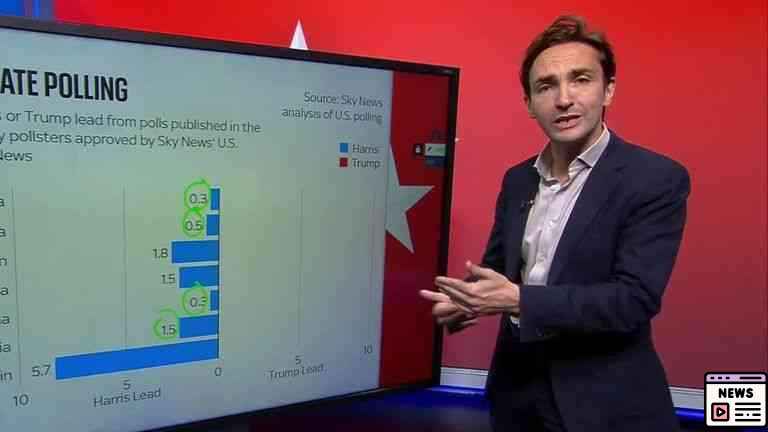Updated on: October 10, 2024 5:41 am GMT
The Battle for the White House Heats Up: Harris vs. Trump
As the U.S. Presidential election approaches, the race between Vice President Kamala Harris and former President Donald Trump is tightening, with recent polling suggesting that Harris holds a slight lead over Trump in what is shaping up to be one of the most competitive elections in recent history. Scheduled for November 5, 2024, the election’s outcome hinges on a few key battleground states that could ultimately determine the next occupant of the Oval Office.
Polling Landscape: Narrow Margins and Battleground Stakes
According to the latest national polls, Kamala Harris is currently leading Donald Trump by a small margin. Harris stands at approximately 47% compared to Trump’s 44%. However, these national averages can be misleading when considering the electoral college system used in U.S. presidential elections, where winning key states is more crucial than amassing a nationwide popular vote.
The current electoral college vote distribution indicates that Harris holds 225 votes, while Trump has 219. To win the presidency, candidates must secure at least 270 electoral votes. Crucially, the remaining 94 votes are concentrated in eight swing states where both candidates are expected to battle fiercely. Harris needs to secure 45 of these votes, while Trump requires 51. The stakes are high, particularly in states like Pennsylvania, Georgia, and North Carolina, where polling indicates a tight race.
How the Electoral College Works
Understanding the electoral college is vital for grasping the nuances of the election. Each state is assigned a number of electoral votes based on its population, totaling 538 nationwide. A candidate needs to obtain a majority of these votes—270—to be declared the winner. Most states operate under a winner-takes-all system, meaning that the candidate who secures the majority of the vote in that state gets all of its electoral votes. However, Nebraska and Maine allocate their votes differently, allowing for a more proportional distribution.
- Key States: Some states have consistently voted for one party. For instance, California and New York have favored Democrats for decades, while Texas has not supported a Democrat since 1976.
- Importance of Swing States: Swing states, which can be won by either party, are crucial for campaign strategies. The same eight states are often highlighted as potential deciders in the electoral outcome, with recent elections showing significant shifts in voter sentiment.
The Odds: Betting Markets and Insights
As both candidates gear up for the final weeks of campaigning, betting markets are beginning to reflect perceptions of likely outcomes. Bookmakers currently favor Trump, indicating a belief that he could gain momentum in the lead-up to the election despite being behind in recent polls. Betting odds often capture a collective sentiment, influenced by real money placed on candidates, providing an alternative perspective to statistical polling.
The current consensus from bookmakers shows that while Harris is leading in the polls, Trump’s odds are encouraging to those betting on his potential for an electoral comeback. This fluctuation highlights the unpredictable nature of American elections as societal moods can shift quickly.
Recent Developments: The Debate Showdown
One of the most anticipated events ahead of the election is the first debate between Harris and Trump, which took place on September 10, 2024, in Philadelphia. Analysts view this debate as a critical moment in the presidential race, as both candidates presented their visions to the nation. Trump’s performance, while criticized by some as lackluster, has also been deemed a potentially pivotal moment, particularly among undecided voters.
Key Moments from the Debate
- Kamala Harris challenged Trump’s past policy decisions, framing her responses within a narrative of progress and responsibility.
- Trump aimed to counter Harris’s points by questioning her administration’s effectiveness, arguing that rhetoric does not equate to results.
As the debates unfold, they will likely influence public opinion and sway undecided voters—factors that could impact polling numbers significantly in the coming weeks.
Looking Ahead: Implications for November
With election day fast approaching, the dynamics of the race could change rapidly. Historical trends show that polling can sometimes underrepresent support for candidates, especially when voter turnout becomes a variable. Both campaigns are ramping up their efforts in battleground states, with strategic messaging aimed at mobilizing their bases while also appealing to swing voters.
Polling firms are adjusting their methods following past discrepancies, attempting to capture a more accurate reflection of likely voters. As final polls are conducted and voting strategies implemented, it remains to be seen whether Harris can maintain her narrow lead or if Trump will once again rise in the polls to secure a path to victory.
In this unpredictable political climate, both candidates are preparing for an election that not only symbolizes a battle for the presidency but also reflects deeper national sentiments and priorities. With opinions divided and tensions high, the outcome on November 5 is poised to be a defining moment in American political history.
Additional Reading and Resources
If you want to learn more about how elections work and how polling is done, there are great resources available. Websites like FiveThirtyEight and 270toWin focus on analyzing and predicting elections. They can help you understand the different factors that influence voting and the results.
